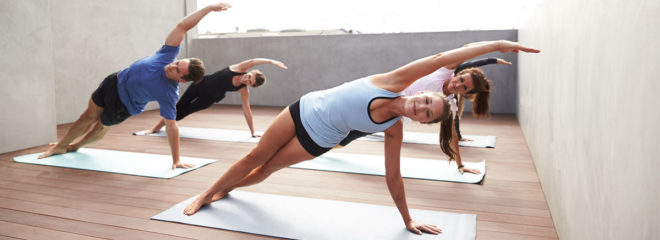By Kathryn Coyle
Rhythm is a fun way to create variations and offer variety for your students. As classical instructors we teach our students that each exercise has it’s own unique rhythm. Webster’s dictionary definite Rhythm as any measured flow or movement, symmetry; the variation of length and accentuation of a series of sounds or an ordered recurrent alternation of strong and weak elements in flow. For Pilates it is a set choreographic pattern performed to a specific beat.
While the rhythm of an exercise always remains the same we can vary the tempo that it is performed at. We can explain tempo as a specific beats per minute or pace. We select the tempo for the exercise based on our student’s abilities and the focus of our lessons.
Finally, we can play with the dynamics. As Pilates instructors we are concerned with quality of movement and movement efficiency. Dynamics will dictate the aspects of execution; how a rhythm and tempo are performed. In movement, it means varying the quality of movement, not just how it looks but how it feels and helps determine mood and quality of movement being elicited. For example the hundred could be preformed smoothly focusing on an even inhalation and exhalation compared to highlighting the strong pumping of the arms.
With these three components of rhythmic teaching there are a variety of variations we can create.
- Slow to quick. Teach the first half of the exercises more precisely and at a slower tempo and then smoothly flow the second half picking up the tempo. Example: Footwork series on the reformer.
- Add a hold. We can change the rhythm of an exercise by adding a hold. Example: Single leg stretch on the mat – “switch, switch, hold and deepen, switch, switch, hold and scoop.”
- Emphasize a specific phase of the movement.Example: Elephant on the reformer – “Press out, pull in 2 3” or try the reverse. “Press out 2 3 and in.”
- Simplify complex syncopates rhythms.Example: Stomach massage on the reformer – In stead of teaching it as an uneven rhythm where the lower lift is much quicker than pressing out and in. You could make each phase of the movement even or take it apart completely, only pressing out and in 8 times and then holding out and lowering and lifting the heels 8 times.
- Create a combination. Example: Long Stretch with Push Up in between reps.
As you play with these simple techniques to create variety and variation in rhythms remember to make sure the tempo is appropriate for the student. If their form starts to fall apart then you are moving too fast. Also keep in mind movement complexity, physical demand and your student’s stage of learning. Keeping these tips in mind as you have fun exploring the wide world of rhythm variations.
Want more Pilates teaching tips? Subscribe to our newsletter today!



